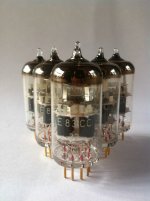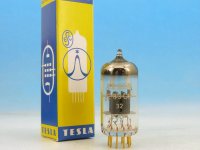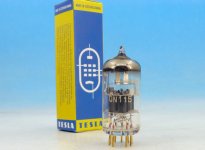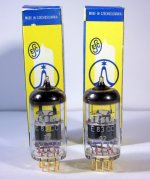Hi all, I'm a novice tube addict, and I've been scratching my head for weeks trying to decipher real Tesla ECC83s from the fakes/relabelled ones. I have read many threads and looked at all the pics I could find. I could use some expert help, as despite my reading up on it, I'm having a heck of a time spotting the genuine goods from the imitations. I also hope this post helps other newbies like me who are having the same difficulty.
Things I've picked up so far: (please let me know if any/all of it is wrong):
1- Real Tesla E83CCs have flatter tops (straighter shoulders if you will), while relabelled JJs (the most common fake) has curved sloped-down shoulders
2- The real getters should be a darker color similar to the Telefunken ECC803s, while many imitations will have lighter-colored getters
3- Real Tesla E83CCs will only have short plates (some fakes do - other fakes have long plates) Long plate Teslas may be real but would be a ECC803s, which, while excellent, is not the same tube.
4- Real Tesla E83CCs will have a frame grid design. Some/most fakes will not.
5- (WRONG - no shielding plate at all on E83CCs) Real Tesla E83CCs will have a black-coated nickel shielding plate between the triodes, JJs will have uncoated gray nickel instead
6- The fakes can be so close in appearance and are so prevalent that even an honest/reputable seller may be fooled.
The first pic is one that I can't tell if it's real or not. To my novice eyes, the top of the tube seems flat and the inner tube construction (what I can see) seems to be a correct Tesla E83CC to me, but I'm just not sure. The 2nd and 3rd pics are of a different example, and I also can't tell if it's genuine. The 4th pic is the last example. I'd greatly appreciate experienced opinions/info.
This site has a ton of information: ECC803S TESLA FAKE TUBES
and FAKE TUBES LIKE ECC803S and others
and Compare of TESLA TUBES with JJ TUBES.
I found this thread useful too: Vintage Amps Bulletin Board • View topic - Tesla ECC803s vs. new production in a Matchless DC30 results
Things I've picked up so far: (please let me know if any/all of it is wrong):
1- Real Tesla E83CCs have flatter tops (straighter shoulders if you will), while relabelled JJs (the most common fake) has curved sloped-down shoulders
2- The real getters should be a darker color similar to the Telefunken ECC803s, while many imitations will have lighter-colored getters
3- Real Tesla E83CCs will only have short plates (some fakes do - other fakes have long plates) Long plate Teslas may be real but would be a ECC803s, which, while excellent, is not the same tube.
4- Real Tesla E83CCs will have a frame grid design. Some/most fakes will not.
5- (WRONG - no shielding plate at all on E83CCs) Real Tesla E83CCs will have a black-coated nickel shielding plate between the triodes, JJs will have uncoated gray nickel instead
6- The fakes can be so close in appearance and are so prevalent that even an honest/reputable seller may be fooled.
The first pic is one that I can't tell if it's real or not. To my novice eyes, the top of the tube seems flat and the inner tube construction (what I can see) seems to be a correct Tesla E83CC to me, but I'm just not sure. The 2nd and 3rd pics are of a different example, and I also can't tell if it's genuine. The 4th pic is the last example. I'd greatly appreciate experienced opinions/info.
This site has a ton of information: ECC803S TESLA FAKE TUBES
and FAKE TUBES LIKE ECC803S and others
and Compare of TESLA TUBES with JJ TUBES.
I found this thread useful too: Vintage Amps Bulletin Board • View topic - Tesla ECC803s vs. new production in a Matchless DC30 results
Attachments
Last edited:
A real E83CC, that is, one made by Mullard/Philips, and other European tubemakers, is a special quality version of the ECC83, similar to the American 12AX7WA.
As such, shouldn't the question be not is it a genuine Tesla?, but is it likely to meet the characteristics, low noise performance, and reliability of the E83CC/12AX7WA?
The tube is a high mu low gm tube for audio use. As such it should not have frame grid construction and should have short anodes. It should have the proper double mica structure at the top.
All teh tubes in your photos have pins/leads that look as though the are the proper dumet metal. I have noticed that Chinese copies typically do not.
As such, shouldn't the question be not is it a genuine Tesla?, but is it likely to meet the characteristics, low noise performance, and reliability of the E83CC/12AX7WA?
The tube is a high mu low gm tube for audio use. As such it should not have frame grid construction and should have short anodes. It should have the proper double mica structure at the top.
All teh tubes in your photos have pins/leads that look as though the are the proper dumet metal. I have noticed that Chinese copies typically do not.
Yes, JJs (of almost any valve type) seem to have very rounded shoulders.johnnyque said:1- Real Tesla E83CCs have flatter tops (straighter shoulders if you will), while relabelled JJs (the most common fake) has curved sloped-down shoulders
Not sure about this one, as no real ECC83 or equivalent can have a shield as there is no spare pin to connect it to. Some Chinese ones do, but I can't think why. As far as I know, the JJ version does not have a shield.5- Real Tesla E83CCs will have a black-coated nickel shielding plate between the triodes, JJs will have uncoated gray nickel instead
I guess that is what the dealers say?6- The fakes can be so close in appearance and are so prevalent that even an honest/reputable seller may be fooled.
Some genuine Tesla (and Telefunken?) ECC83 equivalents are made using a frame grid construction. The JJ 'copy' of the Tesla has anodes which makes it look like a frame grid valve, but I'm not sure that it actually has a frame grid.Keit said:The tube is a high mu low gm tube for audio use. As such it should not have frame grid construction and should have short anodes.
I had a look at the jacmusic site linked in johnnie's post.
Seems to be a mix of bull dust and facts. Example: jacmusic says he has seen tubes that glow very darkly and considers this proof that nasty manufacturers livened up their duff tubes by adding radioactive material to the cathode. Such a tube would be easily detected in electrical testing. It is far more likely that the sealing of the pins to the glass has failed and there is air in the tube.
Seems to be a mix of bull dust and facts. Example: jacmusic says he has seen tubes that glow very darkly and considers this proof that nasty manufacturers livened up their duff tubes by adding radioactive material to the cathode. Such a tube would be easily detected in electrical testing. It is far more likely that the sealing of the pins to the glass has failed and there is air in the tube.
A real E83CC, that is, one made by Mullard/Philips, and other European tubemakers, is a special quality version of the ECC83, similar to the American 12AX7WA.
As such, shouldn't the question be not is it a genuine Tesla?, but is it likely to meet the characteristics, low noise performance, and reliability of the E83CC/12AX7WA?
The tube is a high mu low gm tube for audio use. As such it should not have frame grid construction and should have short anodes. It should have the proper double mica structure at the top.
All teh tubes in your photos have pins/leads that look as though the are the proper dumet metal. I have noticed that Chinese copies typically do not.
Philips and its subsidiaries (Mullard, Valvo etc) introduced the naming system that was adopted by most european manufacturers. Philips put the numbers in between the letters to identify SQ versions (ECC83 vs E83CC) whereas Telefunken added a '0' (ECC803S, EF806). As far as I know only TFK published (and maintained) very strict parameters to which its SQ valves should comply.
So that means that everybody can label a 'SQ' version of their own using the Philips convention. JJ is doing this a bit creatively, as their E34L has slightly different specs than their EL34.
The original Tesla factory produced an SQ ECC83 and so labeled it E83CC. As it is almost identical to the TFK ECC803S I suspect it was made in close cooperation with TFK (possibly as a subcontract to produce actual TFK ECC803S?). And yes, it has a framegrid construction.
Tesla was a producer of valves that could hold their own to Philips and Telefunken and so are getting very sought after. Had I known this in the early 90's, I would have gotten the whole box of of those E83CC's instead of just 1 for curiosity, oh well.
As DF96 said, types equivalent to the ECC83 have no pin to connect a shield between the anodes. Neither the Tesla E83CC nor the TFK ECC803S have such a shield.
In the pictures you provided there is no shield either.
The ECC808 has a shield, but different pinout.
Possibly you are confusing some pictures of E88CC's on the jacmusic site with E83CC's.
The valves in your pictures look identical to my Tesla E83CC.
The one suspicious thing would be the gold pins. Just like mine, the ones on jacmusics site have regular (non shiney) pins.
My camera is not working now, maybe I'll post pictures later.
brothers but not identical twins 
OK, I managed to take some pictures.
Hope it helps.
These are TFK ECC803S (Ulm factory) and Tesla E83CC (Rosnov factory).
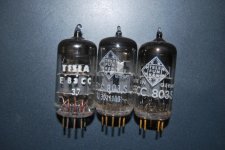
Here you can see how similar they are: framegrid construction and shielded getter ring.
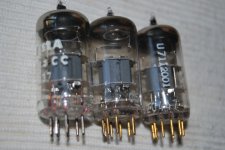
Seen from the top, you notice the small difference in the getter support, with the Tesla being slightly bigger. The getter ring in the Tesla is supported on two points, the TFK only on one. The mica spacers look VERY similar. There is no shield between the individual triodes.
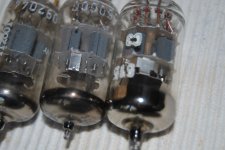
As seen from the bottom it is clear that the pins inside the glass is very red, typical for eastern european production. The spacers are whiter in the TFK. The Tesla doesn't have gilded pins.
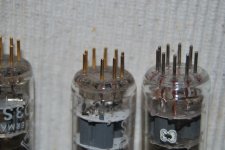
OK, I managed to take some pictures.
Hope it helps.
These are TFK ECC803S (Ulm factory) and Tesla E83CC (Rosnov factory).

Here you can see how similar they are: framegrid construction and shielded getter ring.

Seen from the top, you notice the small difference in the getter support, with the Tesla being slightly bigger. The getter ring in the Tesla is supported on two points, the TFK only on one. The mica spacers look VERY similar. There is no shield between the individual triodes.

As seen from the bottom it is clear that the pins inside the glass is very red, typical for eastern european production. The spacers are whiter in the TFK. The Tesla doesn't have gilded pins.

Hmmmm..
Huge diameter grid support verticals are visible. That indicates the tubes are probably frame grid - but not necessarily. One would have to take a tube apart and see if the to and bottom laterals are there, as well the actual grid wire. Splitting hairs perhaps.
However, it is good confirmation that the tubes have been constructed to be identical, and something other manufacturers probably would not do.
An interesting quirk is the Tesla has copper coloured leads. Only the part inside the glass button should have this colour - it ensures a gas tight seal, but within the tube vacuum it isn't perfect because it is difficult to make free of absorbed gas.
Huge diameter grid support verticals are visible. That indicates the tubes are probably frame grid - but not necessarily. One would have to take a tube apart and see if the to and bottom laterals are there, as well the actual grid wire. Splitting hairs perhaps.
However, it is good confirmation that the tubes have been constructed to be identical, and something other manufacturers probably would not do.
An interesting quirk is the Tesla has copper coloured leads. Only the part inside the glass button should have this colour - it ensures a gas tight seal, but within the tube vacuum it isn't perfect because it is difficult to make free of absorbed gas.
Unfortunately copying the construction is no guarantee to get the same performance.
When Tesla (or was it their owner GE USA) shut down all valve production except transmitting stuff, JJ bought the equipment and set up a factory of his own in Slowakia. The shape of the glass may be different, but the insides of their frame grid types (ECC81/82/83/88) all look the same. I was shown some of their types when I was there in 2001.
So the insides are made on the same tooling, look the same, but use different materials as the originals are no longer available.
When Tesla (or was it their owner GE USA) shut down all valve production except transmitting stuff, JJ bought the equipment and set up a factory of his own in Slowakia. The shape of the glass may be different, but the insides of their frame grid types (ECC81/82/83/88) all look the same. I was shown some of their types when I was there in 2001.
So the insides are made on the same tooling, look the same, but use different materials as the originals are no longer available.
Hi,
They're excellent sounding like most of the Tesla stuff really.
Low noise, low microphony, frame grid, low distortion and long lasting etc.
Cheers,
Can I ask why you are particularly interested in genuine Tesla versions?
Cheers
Ian
They're excellent sounding like most of the Tesla stuff really.
Low noise, low microphony, frame grid, low distortion and long lasting etc.
Cheers,
Thank you, everyone, for all the comments and information. I'd especially like to thank Parafeed813 for sharing so many great photos and all of the explanations. I may be a newb, but when experienced people take the time to respond, I read every word and take notes. Thanks again.
A few of you pointed out that there is obviously no shield. And, yes, indeed I was confusing it with the E88CC, another screen-grid. I've been looking into building a tube preamp using these tubes, and I got my brain wires crossed somewhere. Thank you for pointing that out. If I can, I'll add a little note to my original post to prevent that bad info from being spread.
To answer ruffrecords' question, I'm interested in the Tesla reproduction because I can't afford the legendary Telefunken ECC803s (as Parafeed813 posted in his pic - drool) at the moment. My tube gear is all for studio use, so coloration is another tool/effect for my purposes, not a detriment. I have Telefunken smooth and ribbed plate ECC83s, and they are quite often my favorite in most circuits (only occasionally bested by a Brimar, Mullard, or Amperex to my ears). Since I love those so much, I figured I should give what's usually considered the ultimate Telefunken a try. The Teslas are supposed to be pretty close and are significantly cheaper.
And when re-reading my original post, I wanted to make sure that I didn't come across as slamming JJ tubes. I probably like JJ tubes best out of new production, but in this case, I'm looking for something similar to a Telefunken ECC803s, which the JJ is not the same design. In JJ's defense, I tried one of their 6L6s in an old phono amp that I'm using, and I liked it better than the nos tubes I had on hand in that particular amp (that's never happened to me before). I'd like to shoot it out against an RCA Black Plate 6L6 one day, but that's another thread altogether...
A few of you pointed out that there is obviously no shield. And, yes, indeed I was confusing it with the E88CC, another screen-grid. I've been looking into building a tube preamp using these tubes, and I got my brain wires crossed somewhere. Thank you for pointing that out. If I can, I'll add a little note to my original post to prevent that bad info from being spread.
To answer ruffrecords' question, I'm interested in the Tesla reproduction because I can't afford the legendary Telefunken ECC803s (as Parafeed813 posted in his pic - drool) at the moment. My tube gear is all for studio use, so coloration is another tool/effect for my purposes, not a detriment. I have Telefunken smooth and ribbed plate ECC83s, and they are quite often my favorite in most circuits (only occasionally bested by a Brimar, Mullard, or Amperex to my ears). Since I love those so much, I figured I should give what's usually considered the ultimate Telefunken a try. The Teslas are supposed to be pretty close and are significantly cheaper.
And when re-reading my original post, I wanted to make sure that I didn't come across as slamming JJ tubes. I probably like JJ tubes best out of new production, but in this case, I'm looking for something similar to a Telefunken ECC803s, which the JJ is not the same design. In JJ's defense, I tried one of their 6L6s in an old phono amp that I'm using, and I liked it better than the nos tubes I had on hand in that particular amp (that's never happened to me before). I'd like to shoot it out against an RCA Black Plate 6L6 one day, but that's another thread altogether...
That's my fault  I edited the original post to denote an inaccurate piece of information. I didn't want my ignorance infecting the internet if people only read the first post or 2. Since I'm a newb to the forum, an administrator has to approve my edit before the post will be visible again. Sorry for the inconvenience. I do like that the forum is set up this way to keep out the spam.
I edited the original post to denote an inaccurate piece of information. I didn't want my ignorance infecting the internet if people only read the first post or 2. Since I'm a newb to the forum, an administrator has to approve my edit before the post will be visible again. Sorry for the inconvenience. I do like that the forum is set up this way to keep out the spam.
Hi,
Sorry to say so but that information given by Parafeed813 is not even correct.
If you want history on tube manufacturing, look for the books by Francis Ybre, ask Jack Van de Walle or me.
Cheers,
Thank you, everyone, for all the comments and information. I'd especially like to thank Parafeed813 for sharing so many great photos and all of the explanations. I may be a newb, but when
Sorry to say so but that information given by Parafeed813 is not even correct.
If you want history on tube manufacturing, look for the books by Francis Ybre, ask Jack Van de Walle or me.
Cheers,
Hi all, I'm a novice tube addict, and I've been scratching my head for weeks trying to decipher real Tesla ECC83s from the fakes/relabelled ones. I have read many threads and looked at all the pics I could find. I could use some expert help, as despite my reading up on it, I'm having a heck of a time spotting the genuine goods from the imitations. I also hope this post helps other newbies like me who are having the same difficulty.
Things I've picked up so far: (please let me know if any/all of it is wrong):
1- Real Tesla E83CCs have flatter tops (straighter shoulders if you will), while relabelled JJs (the most common fake) has curved sloped-down shoulders
2- The real getters should be a darker color similar to the Telefunken ECC803s, while many imitations will have lighter-colored getters
3- Real Tesla E83CCs will only have short plates (some fakes do - other fakes have long plates) Long plate Teslas may be real but would be a ECC803s, which, while excellent, is not the same tube.
4- Real Tesla E83CCs will have a frame grid design. Some/most fakes will not.
5- (WRONG - no shielding plate at all on E83CCs) Real Tesla E83CCs will have a black-coated nickel shielding plate between the triodes, JJs will have uncoated gray nickel instead
6- The fakes can be so close in appearance and are so prevalent that even an honest/reputable seller may be fooled.
The first pic is one that I can't tell if it's real or not. To my novice eyes, the top of the tube seems flat and the inner tube construction (what I can see) seems to be a correct Tesla E83CC to me, but I'm just not sure. The 2nd and 3rd pics are of a different example, and I also can't tell if it's genuine. The 4th pic is the last example. I'd greatly appreciate experienced opinions/info.
This site has a ton of information: ECC803S TESLA FAKE TUBES
and FAKE TUBES LIKE ECC803S and others
and Compare of TESLA TUBES with JJ TUBES.
I found this thread useful too: Vintage Amps Bulletin Board • View topic - Tesla ECC803s vs. new production in a Matchless DC30 results
YES, those actual old Tesla's are ******* killer dude....JJ ecc83 and the S are no where near as detailed...imo, Have a few JJ ecc83s that have been really reliable though like years...but damn you know?...Hard to explain man...like a amazing balance of aggressive/detailed/Linear character old ones had....They were even some of my favorites Next to like Blackburn MC1 Mullard Long-plates etc...still have a few, as well as numerous I61/I63 short-plates not as clear/hi-fi like vs the long-plates though.....They are not aggressive at all though....just always that clear/flat/smooth/hi-fi character...
Last edited:
YES, those actual old Tesla's are ******* killer dude....JJ ecc83 and the S are no where near as detailed...imo, Have a few JJ ecc83s that have been really reliable though like years...but damn you know?...Hard to explain man...like a amazing balance of aggressive/detailed/Linear character old ones had....They were even some of my favorites Next to like Blackburn MC1 Mullard Long-plates etc...still have a few,
AudioFreak88, do you happen to recall if your Tesla E83CCs had gold plated pins on the bottom? Some seem to have them and others seem not to. I'm wondering if it just flakes off after enough tube rolling or if the ones with gold plated pins are a warning sign of a fake. I've read they (at least some) came from Tesla with gold-plated pins, but some people here have some that do not.
And, thanks for your feedback! That sounds exactly like what I'm looking for.
Hi,
Sorry to say so but that information given by Parafeed813 is not even correct.
If you want history on tube manufacturing, look for the books by Francis Ybre, ask Jack Van de Walle or me.
Cheers,
Please point out where I am wrong.
We are all here to learn
Hi,
Whilst the Tesla E83CC are excellent, they are nowhere close to the specs of the original TFK specs.
Not that it really matters as the TFK version is so rare that we'll probably never have a chance to compare them anyhow.
Some people prefer the sound of the regular range over the SQ one which often sounds drier, less euphonic say.
BTW, wasn't Philips the inventor of the frame grid construction?
Cheers,
Whilst the Tesla E83CC are excellent, they are nowhere close to the specs of the original TFK specs.
Not that it really matters as the TFK version is so rare that we'll probably never have a chance to compare them anyhow.
Some people prefer the sound of the regular range over the SQ one which often sounds drier, less euphonic say.
BTW, wasn't Philips the inventor of the frame grid construction?
Cheers,
Hi,
They're excellent sounding like most of the Tesla stuff really.
Low noise, low microphony, frame grid, low distortion and long lasting etc.
Cheers,
I have tested a lot of ECC83 types for noise and microphony for use in my mic pre designs. I have found the most consistent to be the Sovtek 12AX7WA. Its noise is always low and for microphonics it beats any other type I have tested.
I think there is little if anything to choose between types in terms of sound. The long plate types have consistently lower distortion but the 12AX7 has a very low intrinsic distortion tube anyway and its contribution to overall distortion as a typical first stage is negligible compared to later higher signal level stages.
Cheers
Ian
- Home
- Amplifiers
- Tubes / Valves
- Tesla E83CC - Have done research & still having trouble spotting fakes from real
